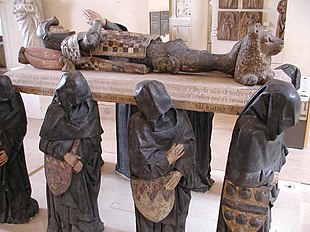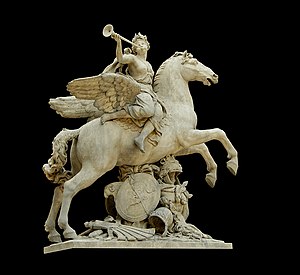Portal:Visual arts
Introduction

The visual arts are art forms such as painting, drawing, printmaking, sculpture, ceramics, photography, video, filmmaking, comics, design, crafts, and architecture. Many artistic disciplines, such as performing arts, conceptual art, and textile arts, also involve aspects of the visual arts as well as arts of other types. Also included within the visual arts are the applied arts, such as industrial design, graphic design, fashion design, interior design, and decorative art.
Current usage of the term "visual arts" includes fine art as well as applied or decorative arts and crafts, but this was not always the case. Before the Arts and Crafts Movement in Britain and elsewhere at the turn of the 20th century, the term 'artist' had for some centuries often been restricted to a person working in the fine arts (such as painting, sculpture, or printmaking) and not the decorative arts, crafts, or applied visual arts media. The distinction was emphasized by artists of the Arts and Crafts Movement, who valued vernacular art forms as much as high forms. Art schools made a distinction between the fine arts and the crafts, maintaining that a craftsperson could not be considered a practitioner of the arts. The increasing tendency to privilege painting, and to a lesser degree sculpture, above other arts has been a feature of Western art as well as East Asian art. In both regions, painting has been seen as relying to the highest degree on the imagination of the artist and being the furthest removed from manual labour – in Chinese painting, the most highly valued styles were those of "scholar-painting", at least in theory practiced by gentleman amateurs. The Western hierarchy of genres reflected similar attitudes. (Full article...)
Selected article

Funerary art is any work of art forming, or placed in, a repository for the remains of the dead. The term encompasses a wide variety of forms, including cenotaphs ("empty tombs"), tomb-like monuments which do not contain human remains, and communal memorials to the dead, such as war memorials, which may or may not contain remains, and a range of prehistoric megalithic constructs. Funerary art may serve many cultural functions. It can play a role in burial rites, serve as an article for use by the dead in the afterlife, and celebrate the life and accomplishments of the dead, whether as part of kinship-centred practices of ancestor veneration or as a publicly directed dynastic display. It can also function as a reminder of the mortality of humankind, as an expression of cultural values and roles, and help to propitiate the spirits of the dead, maintaining their benevolence and preventing their unwelcome intrusion into the lives of the living.
The deposit of objects with an apparent aesthetic intention is found in almost all cultures – Hindu culture, which has little, is a notable exception. Many of the best-known artistic creations of past cultures – from the Egyptian pyramids and the Tutankhamun treasure, to the Terracotta Army surrounding the tomb of Qin Shi Huang, the Mausoleum of Halicarnassus, the Sutton Hoo ship burial and the Taj Mahal – are tombs or objects found in and around them. In most instances, specialized funeral art was produced for the powerful and wealthy, although the burials of ordinary people might include simple monuments and grave goods, usually from their possessions. (Full article...)Selected picture

Selected quote
| “ | Pop art is the inedible raised to the unspeakable. | ” |
| — Leonard Baskin, Publishers Weekly (April 5, 1965) |
Related portals
Selected biography

Herbert James Maryon OBE FSA FIIC (9 March 1874 – 14 July 1965) was an English sculptor, conservator, goldsmith, archaeologist and authority on ancient metalwork. Maryon practiced and taught sculpture until retiring in 1939, then worked as a conservator with the British Museum from 1944 to 1961. He is best known for his work on the Sutton Hoo ship-burial, which led to his appointment as an Officer of the Order of the British Empire.
By the time of his mid-twenties Maryon attended three art schools, apprenticed in silversmithing with C. R. Ashbee, and worked in Henry Wilson's workshop. From 1900 to 1904 he served as the director of the Keswick School of Industrial Art, where he designed numerous Arts and Crafts works. After moving to the University of Reading and then Durham University, he taught sculpture, metalwork, modelling, casting, and anatomy until 1939. He also designed the University of Reading War Memorial, among other commissions. Maryon published two books while teaching, including Metalwork and Enamelling, and many articles. He frequently led archaeological digs, and in 1935 discovered one of the oldest gold ornaments known in Britain while excavating the Kirkhaugh cairns. (Full article...)Did you know (auto generated) -

- ... that Nickelodeon storyboard artists created a book with hundreds of pornographic drawings of SpongeBob SquarePants characters?
- ... that Joseph Binder influenced modern poster design, creating posters for the 1939 New York World's Fair, the U.S. Army Corps and the American Red Cross?
- ... that the documentary comedy films Being Canadian and When Jews Were Funny explore the filmmakers' cultural identity through interviews with dozens of comedians?
- ... that art historian Zehava Jacoby was able to suggest a reconstruction of the lost tomb of Baldwin V of Jerusalem, destroyed in an 1808 fire, using an 18th-century drawing by Elzear Horn?
- ... that in 1933 Nazi sympathisers attempted to kidnap two German-Jewish filmmakers in Liechtenstein?
- ... that although the icosian game was advertised as a "highly amusing game for the drawing room", it was too easy to play and not a commercial success?
- ... that Percy Kelly hoarded his drawings and paintings until the end of his life, saying that his cottage would someday "upstage Beatrix Potter's home"?
- ... that the documentary Lynch/Oz incorporates hundreds of film clips to illustrate the influence of The Wizard of Oz on the work of filmmaker David Lynch?
General images
Major topics
- Types of visual art – Architecture • Art intervention • Ceramic art • Computer art • Drawing • Fashion • Film • Installation art • Land art • Mixed media • Painting • Performance art • Photography • Printmaking • Sculpture • Stained glass
- Art history – Pre-historic art • Ancient art • Art of Ancient Egypt • Art in Ancient Greece • Minoan pottery • Scythian art • Roman art • Women artists
- Western art periods and movements – Medieval art • Gothic art • Renaissance • Mannerism • Baroque • Rococo • Neoclassicism • Romanticism • Realism • Modern Art • Impressionism • Symbolism • Fauvism • Proto-Cubism • Cubism • Futurism • Dada • Art Deco • Surrealism • Abstract Expressionism • Lyrical abstraction • Conceptual Art • Contemporary Art • Postmodern art visual arts.
- Eastern and Middle Eastern art – Buddhist art • Chinese art • Islamic art • Japanese art • Laotian art • Thai art • Tibetan art
- Lists – Architects • Art movements • Art periods • Painters • Printmakers • Sculptors • Statues
- Lists of basic topics – Visual arts • Architecture • Film • Painting • Photography • Sculpture
Subcategories

Architecture | Ceramic art | Comics | Crafts | Design | Drawing | Illustration | Film | Glass | Graphic design | Industrial design | Landscape architecture | Multimedia | Painting | Photography | Pottery | Printmaking | Public art | Sculpture | Typography | Mosaic
Artists | Visual arts awards | Artist collectives | Art collectors | Art critics | Art curators | Visual arts exhibitions | Art forgery | Art history | Visual arts materials | Art schools | Artistic techniques |
WikiProjects
Things you can do
Associated Wikimedia
The following Wikimedia Foundation sister projects provide more on this subject:
-
Commons
Free media repository -
Wikibooks
Free textbooks and manuals -
Wikidata
Free knowledge base -
Wikinews
Free-content news -
Wikiquote
Collection of quotations -
Wikisource
Free-content library -
Wikiversity
Free learning tools -
Wiktionary
Dictionary and thesaurus














































































